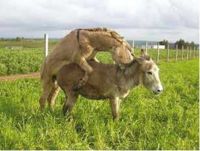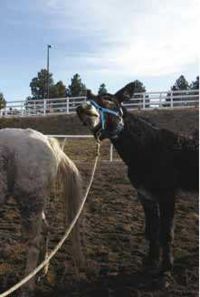| This article has been peer reviewed but is awaiting expert review. If you would like to help with this, please see more information about expert reviewing. |
Male Reproductive Anatomical peculiarities
Sexual behaviour

Sexual behaviour is slightly different from the horse with regard to time of erection and mounting. Jacks seem to have a slower copulatory response especially when breeding with mares for mule production (Gastal et al ,1996; McDonnell, 1998; Tibary, 2006).
Jacks are described as territorial. Each jack has a territory where breeding with solitary females takes place. They defend their territory against any adult males, particularly in the presence of oestrous jennies. They typically interact with jennies in a series of brief episodes, interrupted by a retreat to their resting area.
The pre-copulatory sequence includes vocalization within the resting area, approach and teasing of the sexually active group of jennies, followed by retreat and then sudden approach and brief teasing or mounting. This behaviour may be repeated several times before the jack retreats again to the resting area where erection is achieved before he immediately approaches a jenny and copulates quickly without pre-copulatory behaviour. The precopulatory behaviour sequence includes nose-to-nose contact, nibbling and/or sniffing of the head, neck, back of the knee, body, flank, perineum and tail, olfactory investigation of voided urine or faeces and flehmen.
Achieving an erection at a distance from the jenny is one important characteristic of breeding behaviour. Spontaneous erection and masturbation occur at the same rate as in the stallion with an episode every 90 minutes (Tibary, 2006).
When observing free-ranging jacks, insertion latency, the number of thrusts and the total time mounted has been described as similar to that of stallions. However, in a hand-mating situation and in particular in situations of mule production (jacks breeding with mares) our experience has been that all jacks take an extremely long time until erection and mounting, but once mounting is achieved, ejaculation is generally easily obtained (Tibary et al, 2005; Tibary, 2006).
In-hand breeding

The space and freedom of interaction between the jack and the jenny seems to be a key factor in sexual stimulation. The time to first mount increases if the jenny is restrained (Henry et al, 1991; Gastal et al ,1996). It is recommended that enough space be provided during in-hand mating of a jenny for the retreating behaviour to take place.
The alternating slow/fast approach and retreat to and from the jenny is a unique behaviour in jacks (Henry et al, 1998; Lodi et al, 1994). The number of retreats is generally higher for the first ejaculation than for successive ejaculations (Gastal et al, 1996). The presence of other receptive jennies may enhance the sexual stimulation, whereas the presence of other jacks may distract or inhibit sexual activity given the territorial nature of this species (Kreuchauf, 1984). The time from introduction to a female to mounting and ejaculation varies from 6 to 32 minutes according to studies (Tibary, 2006).
During the pre-copulatory and copulatory phases, jacks exhibit a sequence of behaviour including nose-to-nose contact, flehmen responses, mounting without erection, partial and total exposure of the penis, sniffing and biting specific areas of the female’s body, lip clapping and slow/quick retreats with vocalization. These behavioural parameters show significant individual variations.
The frequency of flehmen response (usually five to eight times) is generally higher than in stallions and does not seem to be affected by rank of ejaculation. The initial reaction of the jack in the breeding shed is vocalization, followed by one or several mounts without erection. The first mount is performed without erection in 70% of the cases. The number of mounts without erection varies from one study to another and is probably affected by training and handling differences (Tibary, 2006).
Frequent partial exposure of the penis during the pre-copulatory phase is common in jacks (Kreuchauf, 1984; Henry et al, 1998; Henry et al, 1991). Total exposure of the penis is generally followed by erection (Gastal et al, 1996). The first erection does not always result in ejaculation. Jacks may show several erections and masturbation before mounting and ejaculation. The mean time from first contact with the jenny until the first erection varies between 10 and 15 minutes. Depending on individual animals, stallions display four to eight pelvic copulatory movements before ejaculation.
A seasonal effect on libido has been reported by some authors with decreased latency to first mount, first erection and ejaculation during spring and summer (the breeding season). This seasonal effect may vary from one region to another (Tibary, 2006).
It is the experience of the authors ( Tibary, A., Sghiri, A. & Bakkoury, M.) that breeding jacks to mares is more challenging with often increased latency to erection, mount and ejaculation.
In pasture breeding systems, lack of conditioning of jacks to breed mares may result in lower reproductive efficiency. It has been suggested that jacks destined for mule production should be raised with horse fillies after weaning, and prevented from any contact with jennies until they are adult (Henry et al, 1998; Henry, 2001).
In pasture, pre-copulatory, copulatory and post-copulatory behaviour for stallions breeding with mares is similar to that for stallions breeding with jennies (Lodi et al, 1994). The interaction between mares and stallions is reportedly shorter in duration but more frequent. Also, jacks seem to elicit signs of oestrus from mares with less intensity. In one study the percentage of oestrous mares exhibiting signs towards a jack varied from 28 to 43% whereas 93% exhibited sexual behaviour to stallions (Lodi et al, 1994; Henry, 2001).
In a stud farm situation, we have observed latency to erection and ejaculation of up to 120 minutes when breeding hobbled oestrous mares (Tibary et al, 2005). In addition to behavioural differences that may affect fertility results, size discrepancy may be another constraint in stallion/ mare breeding.
Breeding evaluation and semen quality
Evaluation of breeding soundness is performed similarly to the stallion. Testicular size, semen volume and total sperm per ejaculate in the jack are significantly higher than in stallions (Tibary et al, 2005). Testicular ultrasonography is characterized by a large central vein and more prominent caput and cauda epididymis. Ultrasonographic evaluation of the accessory sex glands is similar to that of the stallion.
Semen can be collected relatively easily using an artificial vagina (Kadir, 1980; Glatzel et al, 1981). Ex-copula semen collection using imipramine/xylazine has been attempted with very limited success rate (Sghiri et al, 2006).
Semen volume collected by an artificial vagina ranges from 25 to 50ml in miniature donkeys (Purdy, 2005b), from 12.5 to 40 ml in small breeds such as the north African donkey and from 25 to 250 ml in large breeds. In some breeds (Catalonian, Poitou) the gel fraction may be very copious. Very high volumes (115 ml) have also been reported in miniature donkeys (Purdy, 2005b).
Spermatogenic efficiency increases until six years of age, then plateaus (Nipken and Wrobel, 1997; Tibary et al, 2005). The total number of spermatozoa in the ejaculate ranges from 5 to 18 billion. Total progressive motility and normal morphology are generally above 70% in normal healthy males. As in the horse, abaxial attachment of the tail is normal. Sperm abnormalities are similar to those described in horses (Miro et al, 2005; Purdy, 2005b; Tibary et al, 2005). Objective evaluation of donkey sperm motion parameters using computer-assisted motility analysis has been described (Miro et al, 2005; Tibary et al, 2005).
The effect of season (photoperiod and ambient temperature) on semen production, semen quality and libido has been investigated. Semen production and quality are higher during the peak of the breeding season but in most studies seasonal effects on these parameters are not very marked (Glatzel et al, 1981; Roy et al, 2003, 2004; Tibary et al, 2005).
References
- Tibary, A., Sghiri, A. & Bakkoury, M. (2008) Reproduction In Svendsen, E.D., Duncan, J. and Hadrill, D. (2008) The Professional Handbook of the Donkey, 4th edition, Whittet Books, Chapter 17
- Carluccio, A., Villani, M., Contri, A., Tosi, U., and Battocchio, M. (2004). ‘Preliminary study on some seminal and testicular morphometric characteristics in Martina Franca jackass’. Ippologia 15. pp 23-26.
- Gastal, M.O., Henry, M., Beker, A.R., Gastal, E.L., and Goncalves, A. (1996). ‘Sexual behavior of donkey jacks: influence of ejaculatory frequency and season’. Theriogenology 46. pp 593-603.
- Glatzel, P., Kadir, E., and Tibary, A. (1981). ‘Pferde- und Eselhenge der marokkanischen Landespferde- un Maultierzucht. Erste Ergebnisse aus dem Einsatz von Flussig- un Gefriersamen fur die Maultierproduktion’. Berl Munch Tierarztl Wochenschr 94. pp 445-448.
- Henry, M. (2001). ‘Some reproductive characteristics of donkeys’. Pratique Vétérinaire Equine 33. pp 11-20.
- Henry, M., McDonnell, S.M., Lodi, L.D., and Gastal, E.L. (1991). ‘Pasture mating behaviour of donkeys Equus asinus at natural and induced estrus’. J. Reprod. Fertil. Suppl 44. pp 77–86.
- Henry, M., Lodi, L.D., and Gastal, M.M.F.O. (1998). ‘Sexual behaviour of domesticated donkeys (Equus asinus) breeding under controlled or free range management systems’. Applied Animal Behaviour Science 60. pp 263-276.
- Kadir, H. (1980). ‘Production mulassière par le biais de l’insémination artificielle au Maroc’. Thèse de Doctorat Vétérinaire, Institut Agronomique et Vétérinaire Hassan II.
- Kreuchauf, A. (1984). ‘Reproductive physiology in the jackass’. Anim Res Devel 20. pp 51-78.
- Lodi, L.D., Henry, M., Paranhos, D.A., and Costa, M.J.R. (1994). ‘Behavior of donkeys (Equus asinus) breeding mares (Equus caballus) at pasture’. Biol. Repro. Mono 1. pp 591-598.
- McDonnell, S.M. (1998). ‘Reproductive behavior of donkeys (Equus asinus)’. Applied Animal Behaviour Science 60. pp 277-282.
- Miro, J., Lobo, V. , Quitero-Moreno, A., Medrano, A., Pena, A., and Rigaua, T. (2005). ‘ Sperm motility patterns and metabolism in Catalonian donkey semen’. Theriogenology 63. pp 1706-1716.
- Nipken, C., Wrobel, K.J. (1997). ‘A quantitative morphological study of age-related changes in the donkey testis in the period between puberty and senium’. Andrologia 29. pp 149-161.
- Purdy, S.R. (2005b). ‘Ultrasound examination of the female miniature donkey reproductive tract’. in: Veterinary Care of Donkeys. N.S. Matthews and T.S. Taylor (eds). International Veterinary information Service, Ithaca NY (www.ivis.org), last updated: 11 May 2005; A2925.0505.
- Roy, A.K., Yadav, M.P. , and Sengar, O.P.S. (2003). ‘Effect of season on the physical characteristics of donkey (Equus asinus) semen’. Indian J. Anim. Sci. 73. pp 620-622.
- Sghiri, A., Tibary, A., El Idrissi, R. (2006). ‘Behavioral response to imipramine/xylazine treatment in jackass’. Proceedings 9th World Equine Veterinary Congress, Marrakech, In Press.
- Tibary, A. (2005). ‘Pathologie génitale/Infertilité’. Reproduction Equine Tome II: L’Etalon. Tibary, A., and Bakkoury, M. (eds), Actes Editions, IAV Hassan II, Maroc, 2005. pp 185-356.
- Tibary, A. (2006). ‘Normal and abnormal behavior in the male equine’. Current Therapy in Equine Reproduction, J.C. Samper, A. McKinnon and J. Pycock (eds). Saunders, in Press.
- Tibary, A., Bakkoury, M., Anouassi, A., and Sghiri, A. (2005). ‘Examen et évaluation de l’aptitude à la reproduction’. Reproduction Equine Tome II: L’ Etalon. A. Tibary, M. Bakkoury (eds). Actes Editions, IAV Hassan II, Maroc, 2005. pp 167-174.
|
|
|
|